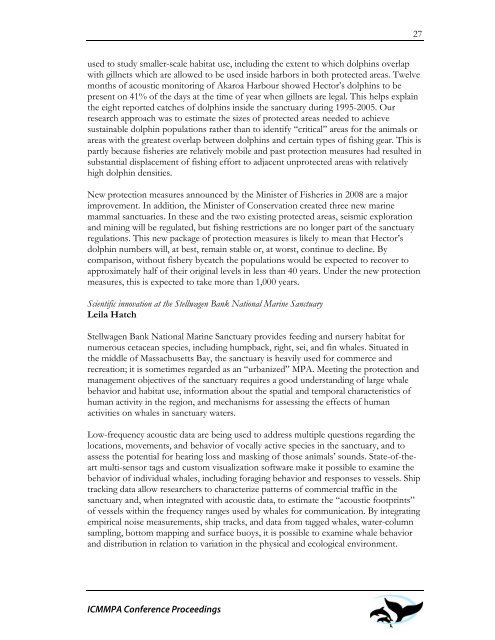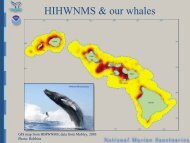The First International Conference on Marine Mammal Protected Areas
The First International Conference on Marine Mammal Protected Areas
The First International Conference on Marine Mammal Protected Areas
You also want an ePaper? Increase the reach of your titles
YUMPU automatically turns print PDFs into web optimized ePapers that Google loves.
used to study smaller-scale habitat use, including the extent to which dolphins overlap<br />
with gillnets which are allowed to be used inside harbors in both protected areas. Twelve<br />
m<strong>on</strong>ths of acoustic m<strong>on</strong>itoring of Akaroa Harbour showed Hector’s dolphins to be<br />
present <strong>on</strong> 41% of the days at the time of year when gillnets are legal. This helps explain<br />
the eight reported catches of dolphins inside the sanctuary during 1995-2005. Our<br />
research approach was to estimate the sizes of protected areas needed to achieve<br />
sustainable dolphin populati<strong>on</strong>s rather than to identify “critical” areas for the animals or<br />
areas with the greatest overlap between dolphins and certain types of fishing gear. This is<br />
partly because fisheries are relatively mobile and past protecti<strong>on</strong> measures had resulted in<br />
substantial displacement of fishing effort to adjacent unprotected areas with relatively<br />
high dolphin densities.<br />
New protecti<strong>on</strong> measures announced by the Minister of Fisheries in 2008 are a major<br />
improvement. In additi<strong>on</strong>, the Minister of C<strong>on</strong>servati<strong>on</strong> created three new marine<br />
mammal sanctuaries. In these and the two existing protected areas, seismic explorati<strong>on</strong><br />
and mining will be regulated, but fishing restricti<strong>on</strong>s are no l<strong>on</strong>ger part of the sanctuary<br />
regulati<strong>on</strong>s. This new package of protecti<strong>on</strong> measures is likely to mean that Hector’s<br />
dolphin numbers will, at best, remain stable or, at worst, c<strong>on</strong>tinue to decline. By<br />
comparis<strong>on</strong>, without fishery bycatch the populati<strong>on</strong>s would be expected to recover to<br />
approximately half of their original levels in less than 40 years. Under the new protecti<strong>on</strong><br />
measures, this is expected to take more than 1,000 years.<br />
Scientific innovati<strong>on</strong> at the Stellwagen Bank Nati<strong>on</strong>al <strong>Marine</strong> Sanctuary<br />
Leila Hatch<br />
Stellwagen Bank Nati<strong>on</strong>al <strong>Marine</strong> Sanctuary provides feeding and nursery habitat for<br />
numerous cetacean species, including humpback, right, sei, and fin whales. Situated in<br />
the middle of Massachusetts Bay, the sanctuary is heavily used for commerce and<br />
recreati<strong>on</strong>; it is sometimes regarded as an “urbanized” MPA. Meeting the protecti<strong>on</strong> and<br />
management objectives of the sanctuary requires a good understanding of large whale<br />
behavior and habitat use, informati<strong>on</strong> about the spatial and temporal characteristics of<br />
human activity in the regi<strong>on</strong>, and mechanisms for assessing the effects of human<br />
activities <strong>on</strong> whales in sanctuary waters.<br />
Low-frequency acoustic data are being used to address multiple questi<strong>on</strong>s regarding the<br />
locati<strong>on</strong>s, movements, and behavior of vocally active species in the sanctuary, and to<br />
assess the potential for hearing loss and masking of those animals’ sounds. State-of-theart<br />
multi-sensor tags and custom visualizati<strong>on</strong> software make it possible to examine the<br />
behavior of individual whales, including foraging behavior and resp<strong>on</strong>ses to vessels. Ship<br />
tracking data allow researchers to characterize patterns of commercial traffic in the<br />
sanctuary and, when integrated with acoustic data, to estimate the “acoustic footprints”<br />
of vessels within the frequency ranges used by whales for communicati<strong>on</strong>. By integrating<br />
empirical noise measurements, ship tracks, and data from tagged whales, water-column<br />
sampling, bottom mapping and surface buoys, it is possible to examine whale behavior<br />
and distributi<strong>on</strong> in relati<strong>on</strong> to variati<strong>on</strong> in the physical and ecological envir<strong>on</strong>ment.<br />
ICMMPA <str<strong>on</strong>g>C<strong>on</strong>ference</str<strong>on</strong>g> Proceedings<br />
27



